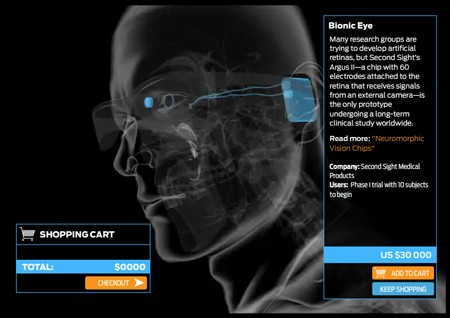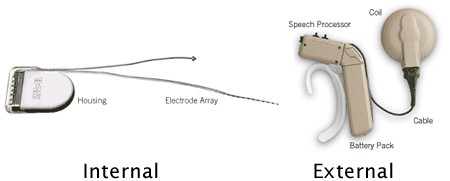
Various cybernetic limb and organ replacements were recently featured in IEEE’s flash demo called The Bionic Body Shop, but we were most interested by the bionic eye and the cochlear implant (we already discussed the featured powered exoskeleton). These are notable for the fact that they are not merely high-tech prosthetic replacements strapped to or worn on the body, but implants that are housed within the body and work with flesh-and-blood sense organs on a much closer level than any preceding technology.
The Argus II Retinal Stimulation System is biotech firm Second Sight’s bionic eye, and it works by attaching 60 electrodes directly to the retina that stimulate light and dark receptors to form an image the human brain can parse. The electrodes are also connected to a small housing unit implanted more deeply within the skull; the housing unit contains a battery, video processor, and wireless receiver. The receiver gets video data from a small camera mounted in a pair of glasses. The technology is currently in clinical trials using only patients over 50 who have suffered gradual loss of vision as opposed to lifetime blindness.

Minimal data about cochlear implants was in the flash demo, so we chose one manufacturer, Med-El, to learn more. Their implants work much in the same way as the retinal implants, with a cranially implanted housing for electronic components and an electrode array directly stimulating the user’s cochlea. A speech processor worn externally picks up sounds and converts it to digital data. The data is transmitted by a coil to the receiver in the internal housing, which relays it to the electrodes. The electrodes stimulate the cochlea and the user hears the sound. Though these are available now, only patients with severe hearing loss are eligible.
One interesting thing to note about both devices is that they stimulate sensory organs directly with digital data. While the most practical applications are to recover lost or damaged sensory sensitivity, it’s not inconceivable to think that these could also become available to anyone and be used to stream music directly into your ear or visual data like text or images directly into the eye. Fun stuff, just make sure the procedure doesn’t drive you insane.
















although retinal implants would be FRIGGIN SWEET, my pessimism can’t help but think of how we’ll be constantly fed advertising through our wireless implants.
the future: potentially very awesome, most likely gonna suck.
I love the idea of having an ‘extra’ input for sight or sound. The ability to render information (either auditory or visual) without any external equipment presents so many uses it’s hard to imagine them all.
What is more interesting to me is the idea of connecting digital systems directly to the senses. The human brain is marvelously adaptable, and it boggles the mind to imagine what could be accomplished by imaginative scientists.
I can’t remember where I read it, maybe here or engadget or one of the news sites but if memory serves me right the university of washington is working on a sort of contact lenses that they’re saying has varied uses including zoomable targeting for those of the world in combat-related careers and hopefully plain grad students like me who want to be able to see a half mile away on command.
I have a second cousin with cochlear implants. Apparently, he found out his wife of 10 years has an annoying voice. Now, he makes judicious use of the off switch.
Seriously.
Where is the instructable?! Circuit diagrams? Howto?
There is none? This is no hack!!!!!!!!!
Of course I joke. This is very interesting stuff and I remember when I first heard about bionic eye and its tiny 16×16 resolution.. all I could think about was ‘how long till they get a resolution suitable for super mario bros to be played directly to your brain?’. The concept of digital devices interfacing with our biological brains is ..mindboggling.. there really is no limit. I also fear this kind of engineering will be the death of human kind.
What happened to making fun of people wearing “coke bottle” glasses.
@rj-
really? I wonder if the earth will turn square. Bill gates will be our leader and we’ll assimilate the martians.
I think we’ll have a lot of the same issues we have today, in a different scale- you’re likely to require a personal firewall and some virus protection. The insulin pump and pacemaker that work with your body’s network will have to be protected!
What would be really cool is if they could make these like infrared night vision type of thing. Or maybe turn up/down the sensitivity of different wavelengths of light, that would be handy looking at nebulas and stuff through a telescope.
The idea is great but how much will i suck when someone hacks the inplants and startes sending gay porn dirrectly to your eyes!
If you could integrate night vision with a full color spectrum you wouldn’t have to turn on the lights at night. Which would save power. Justifying the cost of implanting something in your head.
Michael Criton wrote the book many years ago “Terminal Man”. They connected electrodes to the brain of a human. I do not remember the pretenses as to why they did it, but eventually he went mad and was running around killing people.
Yesterdays Science fiction is tomorrows reality.
Prepare to be be be assimilated, resistance is is is is futile!
directly mostly towards fozz…has anyone ever read the book “Feed”? looks like we’re just one step closer.
First thing that comes to mind is, multiple monitors increases productivity, what about multiple eyes?
Full range 4D high def vision would be interesting, you would be able to see doppler shift as the light passes around your head, if tuned correctly.
What about linking brains together in a vlan across the internet to accomplish greater tasks like distributed computing processes are done now?
The overall implications are startling although I agree with the pessimism. Prime example: The internet. Built originally for communications and sharing of knowledge, the corporate world took it over and it is all about money now.
Oh well, still cool stuff.
This is truly awesome – imagine browsing the internet just by thinking!